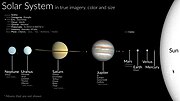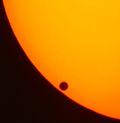 | The vulcanoids are a hypothetical population of asteroids that orbit the Sun in a dynamically stable zone inside the orbit of the planet Mercury. They... 22 KB (2,535 words) - 11:17, 15 April 2024 |
Transit of minor planets (redirect from Transit of asteroids) include Aten asteroids (including Apohele asteroids and the hypothetical Vulcanoid asteroids) and some Apollo asteroids (perhaps including quasi-satellites... 4 KB (635 words) - 04:47, 3 September 2023 |
later accounted for via Einstein's General Theory of Relativity. Vulcanoids, asteroids that may exist within a gravitationally stable region inside Mercury's... 20 KB (2,247 words) - 13:55, 26 April 2024 |
 | parallax during the 2004 Transit of Venus as well as the search for Vulcanoid asteroids. He was also involved in politics as a Sunnyvale, California city... 6 KB (394 words) - 13:24, 10 June 2023 |
 | List of minor-planet groups (redirect from Asteroid group) such, the names they have been given are provisional. Vulcanoid asteroids are hypothetical asteroids that orbit entirely within the orbit of Mercury (have... 18 KB (2,395 words) - 17:48, 6 March 2024 |
 | 3 Juno (redirect from Juno (asteroid)) (minor-planet designation: 3 Juno) is a large asteroid in the asteroid belt. Juno was the third asteroid discovered, in 1804, by German astronomer Karl... 26 KB (2,297 words) - 20:29, 25 April 2024 |
 | Solar System (section Asteroids) asteroid populations that are not in the asteroid belt and within Jupiter's orbit (see also § Centaurs, trojans and resonant bodies): No vulcanoids,... 204 KB (20,519 words) - 07:07, 29 April 2024 |
 | Near-Earth object (redirect from Near-Earth asteroid) within the orbit of Venus and which include the hypothetical sub-group of Vulcanoids, which have orbits entirely within the orbit of Mercury. The Atens have... 146 KB (15,424 words) - 12:30, 29 April 2024 |
 | James Craig Watson (category Discoverers of asteroids) Mercury, which is now known not to exist (however the existence of small Vulcanoid planetoids remains a possibility). He believed he had seen such two such... 14 KB (1,305 words) - 05:05, 3 January 2024 |
(434326) 2004 JG6 (category Atira asteroids) of Venus. Therefore, it does not fit the criteria for a vulcanoid or ꞋAylóꞌchaxnim asteroid, which would require it have a wholly intra-Mercurian and... 7 KB (462 words) - 18:48, 27 November 2023 |
B612 Foundation (section Asteroid deflection workshop) collisional and dynamical evolution of main-belt and near-Earth asteroids, Vulcanoids, Kuiper belt comets, and interplanetary dust." He is the author... 143 KB (13,906 words) - 06:36, 3 November 2023 |
valleys Largest lakes Hypothetical Planet Nine Five-planet Nice model Vulcanoids Tyche Nemesis Planets beyond Neptune Claimed moons of Earth List of hypothetical... 11 KB (272 words) - 03:28, 2 April 2024 |
 | 594913 ꞌAylóꞌchaxnim (category Atira asteroids) 5 km (0.93 mi). Vulcanoids – a hypothetical population of asteroids within Mercury's orbit 2019 AQ3, a dynamically-changing Atira asteroid that may have... 32 KB (2,766 words) - 19:01, 7 February 2024 |
planet once thought to be between Mercury and the Sun Vulcanoid, a hypothetical population of asteroids between Mercury and the Sun Vulcan (programming language)... 7 KB (868 words) - 15:27, 8 January 2024 |
 | and Neptune; Ceres and other bodies later recognized to be part of the asteroid belt; and Pluto, later found to be the largest member of the collection... 195 KB (20,575 words) - 05:22, 26 April 2024 |
with an altitude of 21.9 to 26 km. The central peak of Rheasilvia on the asteroid Vesta is also a candidate to be the tallest, with an estimated at up to... 53 KB (3,855 words) - 09:06, 20 April 2024 |
 | as having given its name to the hypothetical vulcanoids. "Cerberus" is already the name of an asteroid, 1865 Cerberus, but the Greek form of the name... 21 KB (1,926 words) - 15:18, 10 April 2024 |
oceans or seas are suspected to exist on some of Saturn's other moons, the asteroid Ceres, the larger trans-Neptunian objects, and ice planets in planetary... 21 KB (1,252 words) - 17:22, 27 April 2024 |
 | 2021 PH27 (category Atira asteroids) fractures on the asteroid. As of 2023, this minor planet has neither been numbered nor named by the Minor Planet Center. Vulcanoids, a hypothetical population... 16 KB (1,300 words) - 21:35, 14 January 2024 |










